Sedum Caustic - care and methods of reproduction
In modern landscape design, sedum is one of the most popular crops, which has several vibrant varieties. The homeland of growth is Africa, Eurasia, North and South America. Consider what the plant looks like, what subspecies exist, and how to properly care for them.
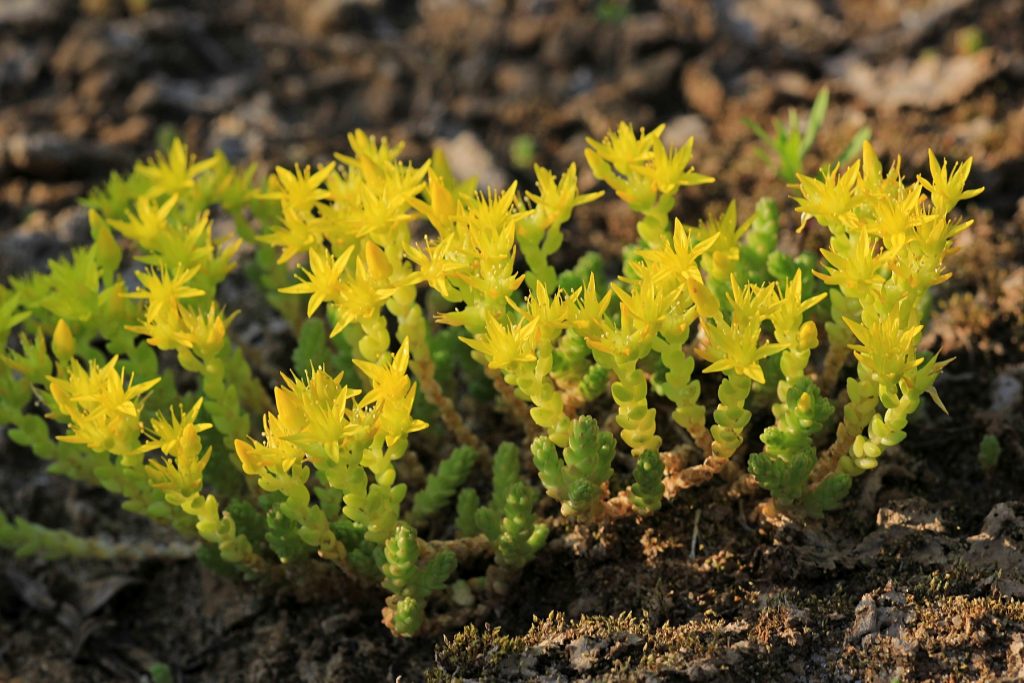
Sedum caustic planting and care
Description of the plant
Among the people, sedum has received several names - living water, squeak, hernial grass and rejuvenated. In Latin - sedum (sedum).
Perennial or biennial herb with large, thick leaves of different tones. Inflorescences are stellate, bisexual, of various colors, collected in shields, umbrellas or brushes, depending on the variety.
Flowering occurs in the summer or autumn season.
This ornamental crop is considered a honey plant and attracts bees to the garden. Tropical varieties are suitable for indoor cultivation, winter-hardy perennials with ground cover or vertically growing stems take root well in flower beds, in flower beds.
Popular varieties
After reading a detailed description of all varieties, you can choose the most suitable varieties for decorating your garden.
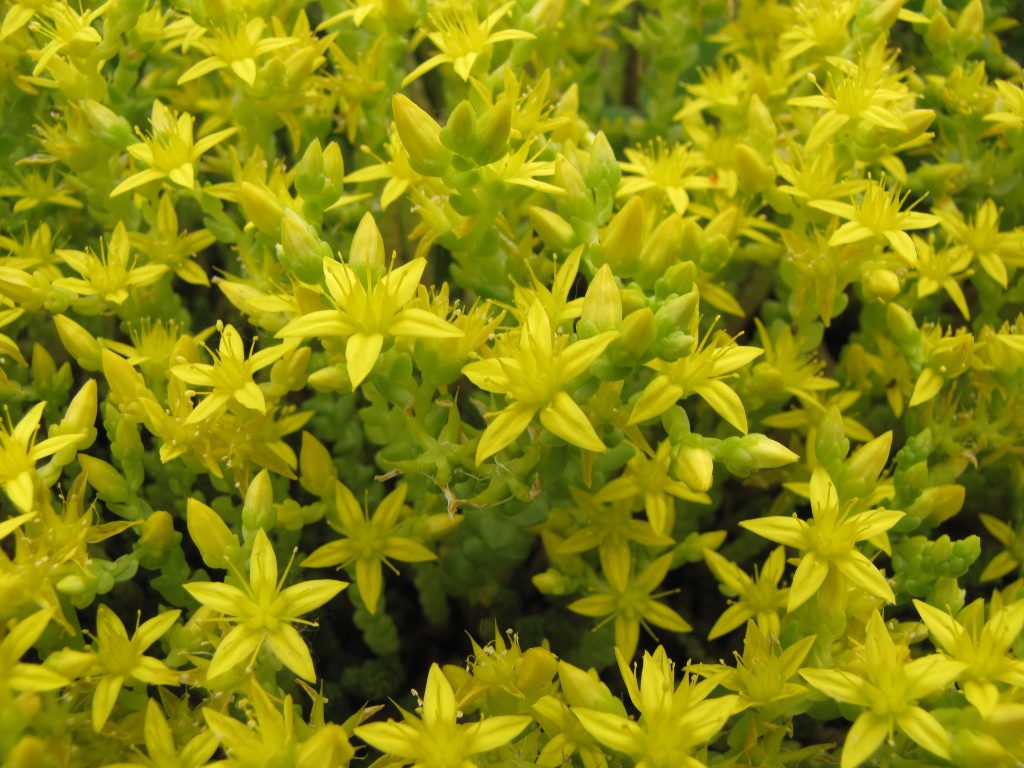
Sedum caustic photo
ANDureum
The botanical name is Sedum acre aureum. The plant is widespread in the Caucasus, Western Siberia, Asia Minor, North America and the European part of Russia.
The variety got this name thanks to the milky juice, which, when it gets on the skin and mucous membranes, causes severe irritation.
Dwarf culture up to 10 cm high with cylindrical branched stems. The leaves are smooth, fleshy, alternate, 6 cm long. The flowers are golden yellow, 1.5 cm in diameter, collected in semi-umbellate inflorescences.
Elegans
The botanical name is Sedum acre elegans. Perennial ground cover no more than 10 cm in height, forming turf with a circumference of 20 cm. Leaves are dense, fleshy, glabrous, winter well.
The flowers are pale yellow, collected in half-umbrellas, 1.5 cm in diameter.
The variety is valued for its abundant flowering and universal application - it is suitable for growing on alpine hills, rocky compositions, along the walls of the house, outbuildings.
Minus
A beautiful lush creeping bush that forms a dense turf. Stems are cylindrical, highly branched. The leaves are fleshy, emerald, arranged alternately, tolerate wintering well, without losing their decorative qualities.
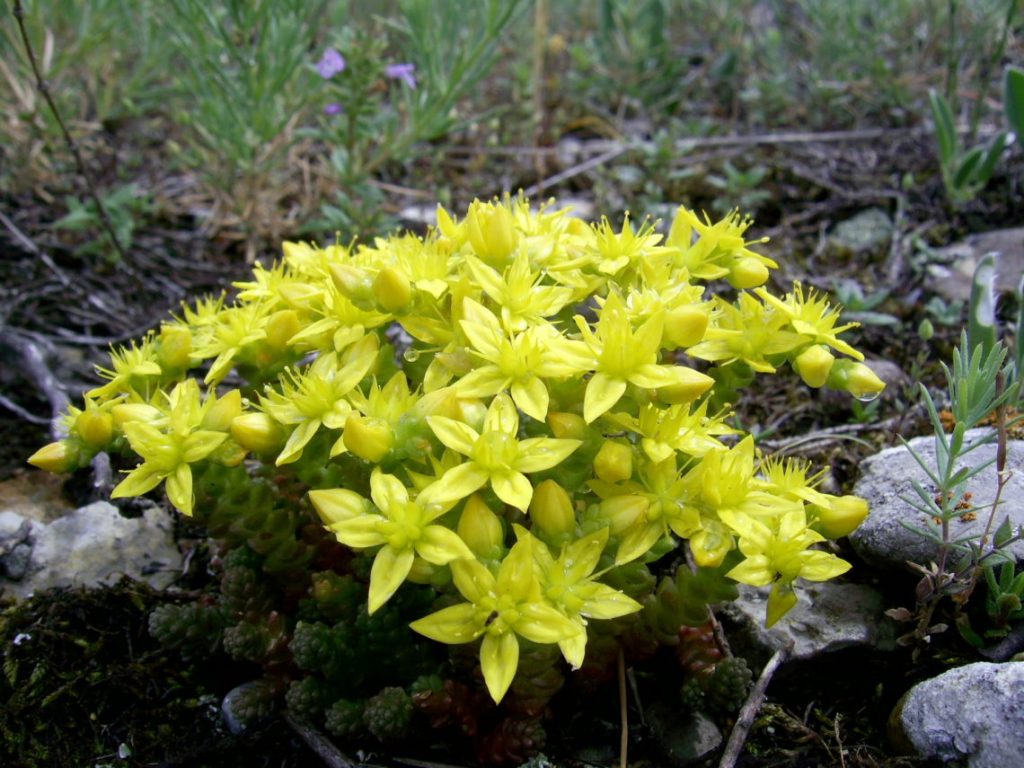
Sedum caustic cultivated weed
Flowers are yellow, densely cover the entire surface of the bush.
Prominent
The name in Latin is hylotelephium spectabile. The homeland of growth is North Japan, Korea and the northeastern part of China.
The description includes:
- medium-sized plant, reaching 50 cm in height;
- has a tuberous root system;
- stems are erect, glabrous;
- the leaves are green with a bluish tint, large, oval in shape with jagged edges;
- flowers are small lilac-pink or carmine-purple, about 1 cm in diameter, collected in semi-umbellate inflorescences.
White
The botanical name is sedum album. Popular in North Africa, Asia Minor, Western Europe and the Caucasus.
The flowers of this variety are fragrant, snow-white, collected in panicles. The plant is evergreen, perennial, ground cover - the height of a dense carpet is 5-6 cm.The leaf plate is oval, twisted, up to 10 cm long.
Yellow queen
The botanical name is sedum acre yellow queen. Translated means yellow queen.
A low-growing culture up to 10 cm high with small, fleshy leaves of a light green-lemon shade. During the flowering period, the bush is decorated with small flowers of a yellow-lemon tone, with a circumference of 1.5 cm.
The variety is valued for its long decorative effect - flowering lasts 1.5-2 months. Differs in increased winter hardiness, therefore it is suitable for cultivation in all climatic zones of our country.
Purchase and adaptation
Seeds can be purchased at any gardening store. When buying, pay attention to their expiration date.
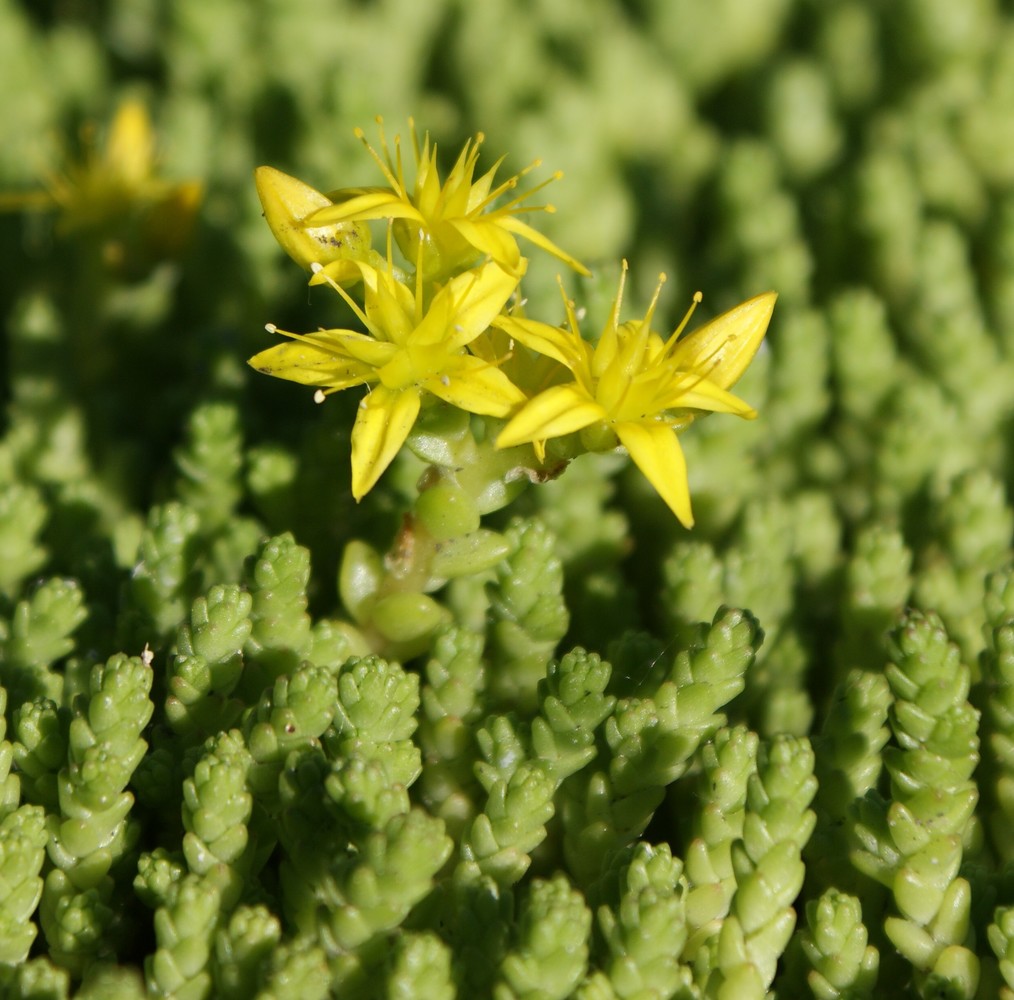
Sedum caustic cultivation from seeds photo
You can also buy ready-made seedlings in pots or containers. It is important that the aerial part is fresh, juicy, stems and leaves without yellowness, black, red spots, growths. Shoots of strong bushes do not contain cracks or breaks. The soil is slightly moistened without mold, acidification and parasites.
It is better to buy garden flowers in spring, so that after transplanting into open ground over the summer they have time to take root and build up green mass.
Choose flowering specimens - this way you will be sure that you have exactly the variety you need. In addition, a blooming stonecrop indicates the absence of health problems.
The purchased plant is kept in a pot for several weeks to determine if it has diseases and parasites. If everything is in order, after the end of flowering, when the street temperature stabilizes within 14-15 °, they begin to transplant to the flower garden.
Landing rules
This horticultural crop loves to grow in areas where there is diffused daylight. She is not suitable for sunshine or constant shading. In the first case, the foliage and inflorescences will quickly burn out, in the second, sedum will develop poorly, bloom poorly and stretch out.
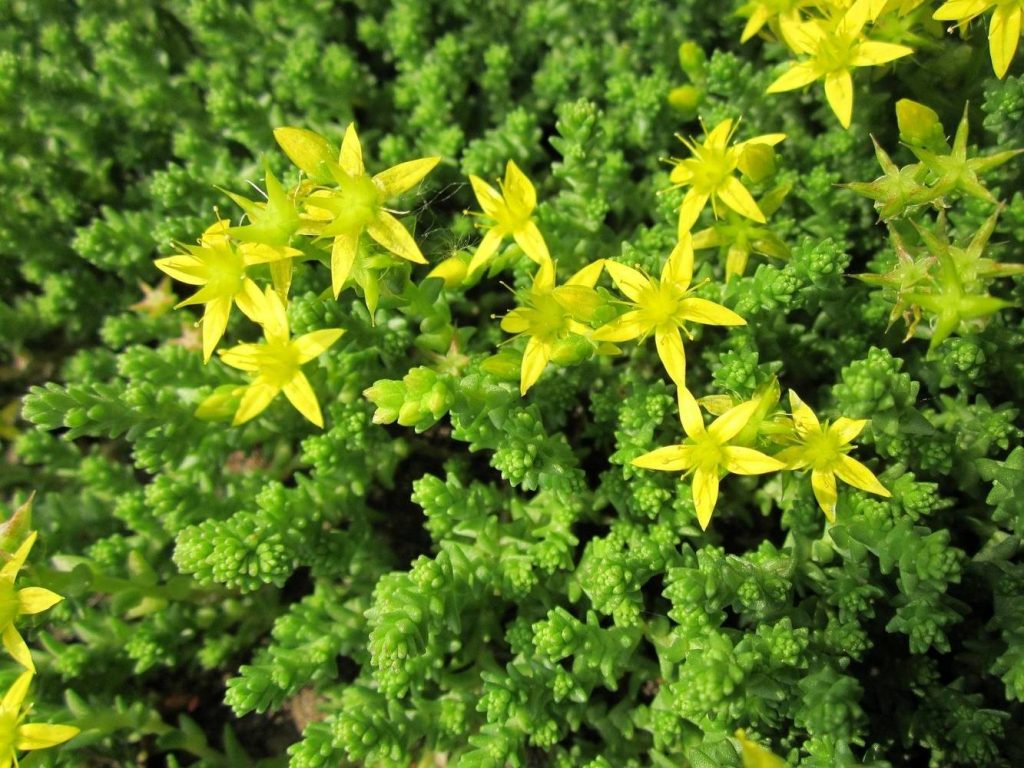
Sedum caustic photo description
Choose a location under tall shrubs or densely crowned trees that provide the necessary shade for flowers at lunchtime.
The site should be protected from winds and with a deep passage of groundwater, since this plant does not tolerate waterlogging and begins to rot.
Priming
The soil is loamy, or even better - rocky. But before planting, it must be flavored with organic components - rotted manure or compost.
It also develops poorly on acidified soil, the optimal acidity level is 6-7 units. For deoxidation, you can use chalk, slaked lime, calcite - 400 g per 1 m².
Before planting the seedlings, all the garbage, the remains of last year's vegetation are removed on the site, then organic matter is introduced, if a deoxidizer is needed, dug up, leveled and watered abundantly.
The necessary conditions
Sedum caustic will fully grow and bloom luxuriantly if it is provided with several vital conditions.
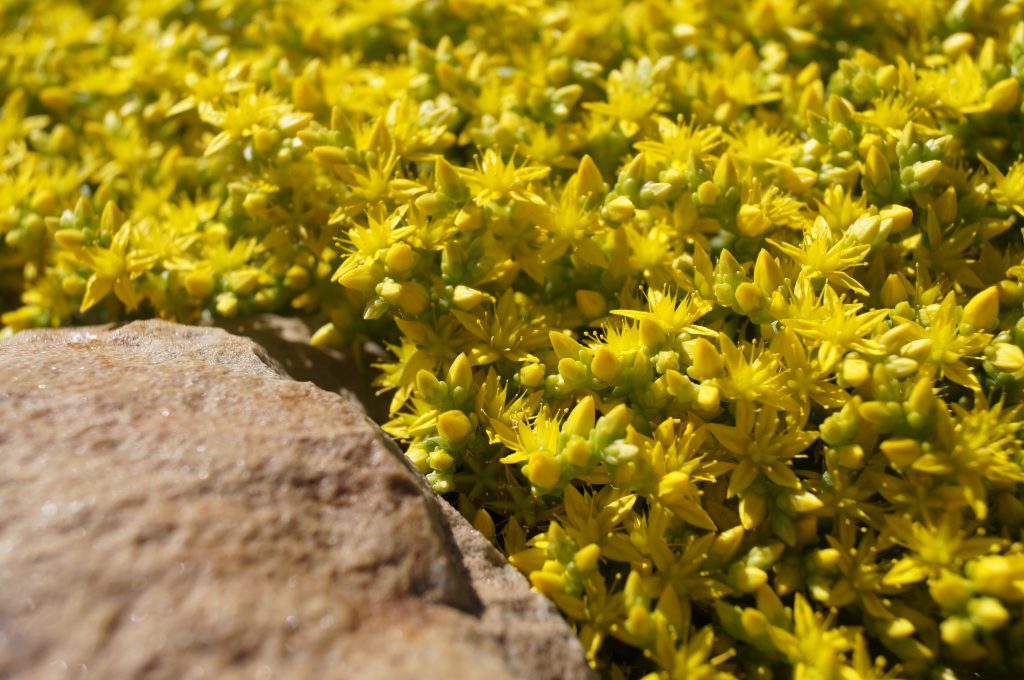
Sedum caustic sedum
Lighting
This plant has a long daylight hours - it needs diffused daylight in the morning and evening for at least 8 hours, from spring to late autumn.
It is planted in places where the sun shines all day and there is a slight shade at lunchtime. Due to a lack of lighting, the leaves turn pale and the inflorescences develop pale, the flowering is not so abundant.
Temperature
Optimum performance during the growing season is 20-25 ° C. In the cold season, it withstands a decrease to -30 ° C.
The plant does not tolerate strong winds, especially in winter, therefore, when planting in an open area, it is better to insulate the bushes for the winter - to sprinkle with peat, humus and cover with spruce branches.
Humidity
It responds well to frequent sprinkling of the crown, especially in hot summer. Irrigation is carried out in the evening every 3 days.
Spraying stimulates the growth of stems, leaves, improves the quality of flowering, prevents the appearance of harmful insects.
Care
Watering
- In spring and summer, water is watered as the soil dries up to a depth of 3-4 cm, taking into account seasonal precipitation. On rainy days, watering can be completely abandoned, because the bush tolerates drought well.
- Water less often in autumn - twice a month. Humidification is stopped 3 weeks before the onset of the first persistent cold weather.
The procedure is best done in the evening. Use warm water to avoid root rot.
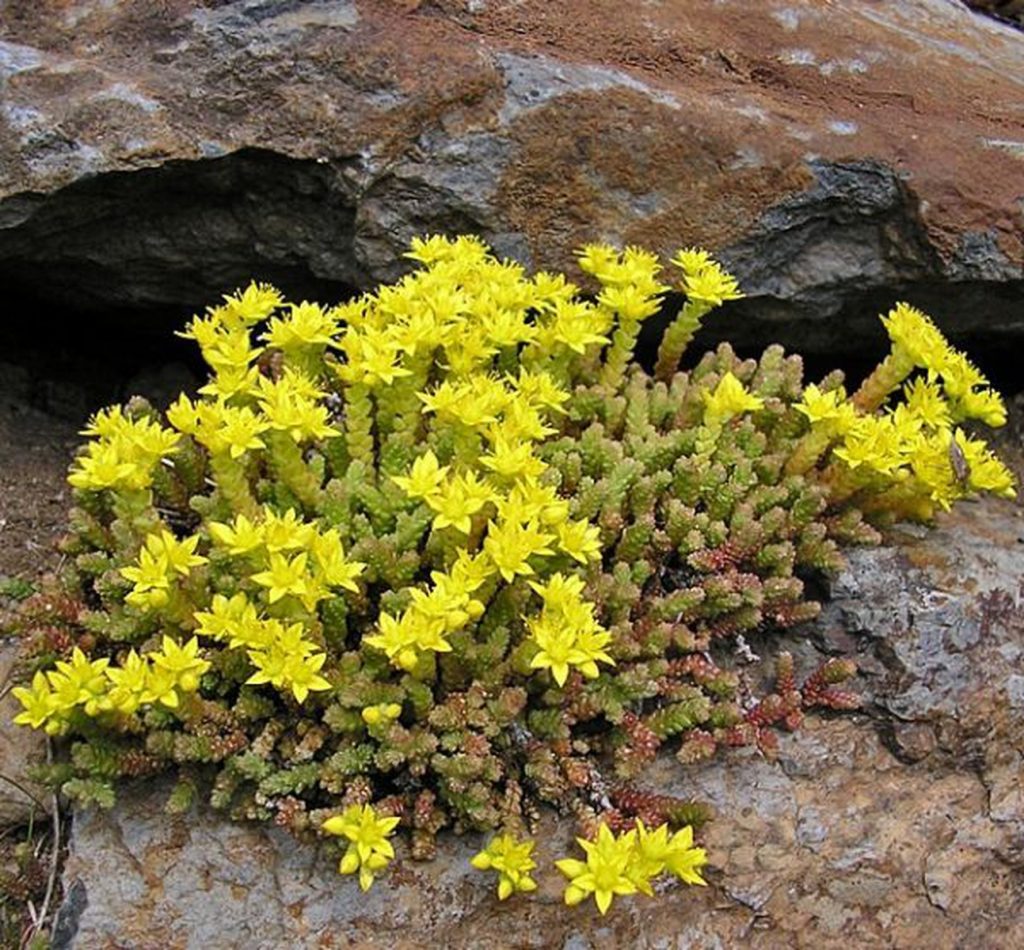
Sedum caustic sedum acre aureum
After - it is necessary to loosen the near-trunk zone and row spacings - this helps to keep the soil light and loose.
To prevent rapid evaporation of moisture, the stems are mulched with peat, garden soil or compost.
Top dressing
These flowers are fed twice a year - in spring and autumn.
Mineral complex fertilizer or organic matter is used. Solutions based on mullein (1:10) and poultry droppings (1:20) have proven themselves well.
After the procedure, abundant watering is carried out so that the root system absorbs nutrients faster and does not get burns.
Pruning
These flowers do not need crown correction, only annual sanitary pruning is required throughout the growing season. All dubious stems are cut out - shrunken, rotten, broken, damaged by diseases and parasites.
For this manipulation, a sharp and sterile pruner is used to avoid contamination of the sedum with some kind of infection.
Closer to the first frost, a cardinal haircut is carried out - shoots are cut off at ground level. Then they spud with peat and cover with spruce branches or burlap.
Transfer
Purchased flowers are transplanted when they bloom. To eliminate the risk of injury to the roots, before removing them from the pot, they are plentifully spilled with water, then transferred together with a lump of earth into a previously prepared hole.
Stonecrops growing in one place for more than three years also need a transplant. Replacing old soil with fresh and fertile soil will stimulate their growth and development.
It is necessary to transplant plants that have suffered from frequent waterlogging and their roots have begun to rot. The bushes are watered, dug out, washed from the soil from the root system, removed all damaged areas, dried, treated with a fungicide, then planted in a permanent place in the garden.
Reproduction methods
Stonecrop can be propagated by cuttings or by dividing the bush.
Growing from seeds is ineffective, because the seed collected from the bush on the site has poor germination.
Cuttings
Apical shoots are cut in spring or summer.
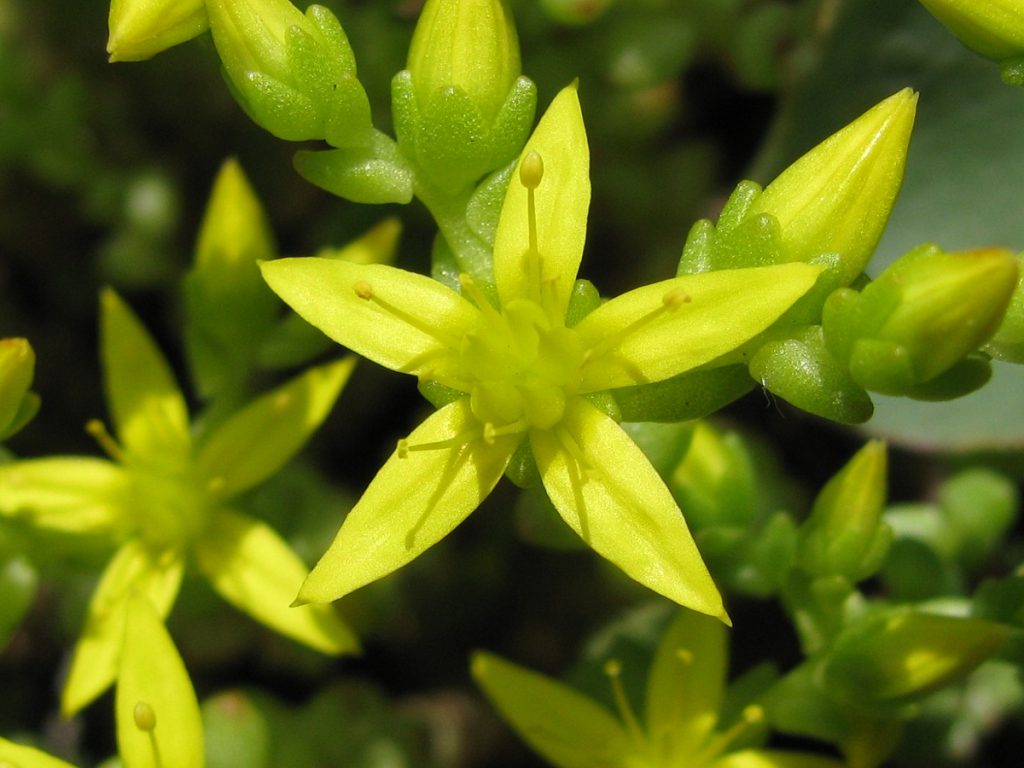
Seemed sedum acre
Cuttings 12-15 cm long are cut, freed from leaves in the lower part, then dipped into a container with water with the addition of Epin for a day. They are planted in seedling boxes filled with peat and sand (1: 1). Moisten, cover with a transparent film, put in a warm place.
Germination can take 2 to 3 weeks. During this time, the seedlings need to be periodically sprayed, ventilated every day. As soon as they release new leaves, the shelter is removed, grown for another month at home, then transplanted into a flower garden.
By dividing the bush
This method is often used when you need to rejuvenate an old bush. It is watered, dug out, the roots are washed in water, then divided into several parts. Each delenka should have 1 shoot and 2-3 roots. Places of cuts are sprinkled with charcoal.
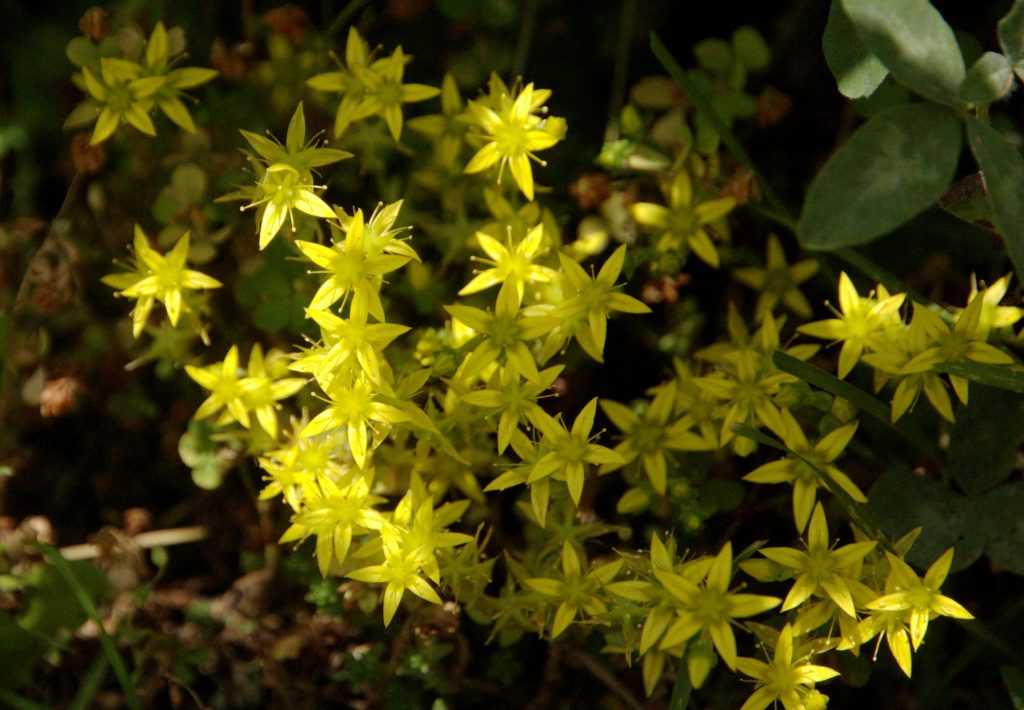
Sedum caustic plant
Seedlings are planted separately according to the above described planting scheme.
Diseases and pests
The garden perennial has good immunity against diseases and parasites, but if the rules of care and maintenance are violated, it easily becomes infected with them.
| Pests and diseases | Symptoms | Treatment methods | Prophylaxis |
| Aphid | It settles in colonies on the underside of leaves, feeds on their sap, leads to yellowing, curling and shedding | At the initial stage of the lesion, treatment with a solution of laundry soap (40 g per 1 liter of water) can be carried out. In case of a strong invasion, they are treated with Karbofos or Aktellik | Weed the aisles regularly, remove weeds in time, avoid thickening of the plantings |
| Thrips | A whitish sticky coating on the surface of the leaves, which is left by small worm-like insects. Eats out tissue, leads to their death | Collect the parasites along with the plaque using a cotton pad dipped in fungicide. Sprinkle the crown with Aktellik or Aktara | Buy healthy plants, treat the soil with fungicides before planting |
| Fungal rot | Infection can be on stems, roots, leaves. The areas affected by the fungus darken, become covered with a mucous coating | Sick areas are cut out, the crown is treated with antifungal drugs - Fitoverm or Ridomil gold. They also spill the soil with a solution of copper sulfate. | Avoid thickening of plantings, overflows, remove infected parts in time and spray with fungicides |

